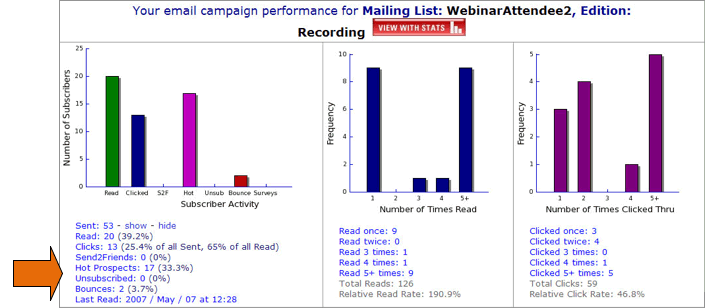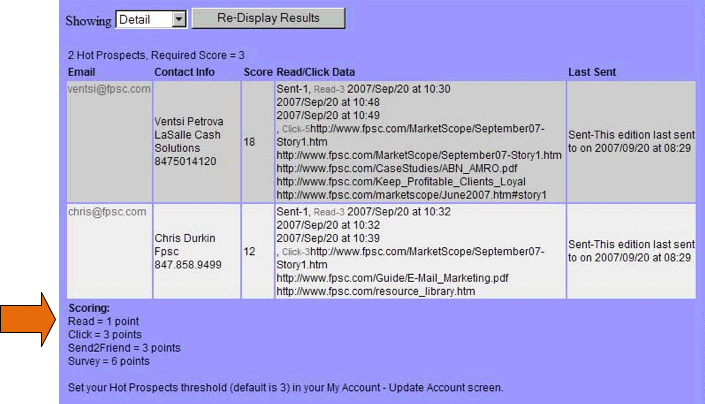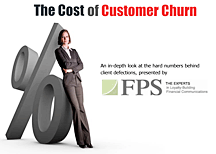 |
 |
| April 2011 |  |
What we do |  |
Testimonials |  |
Forward to a Colleague |
|
The Financial Institution's Guide to Digital Marketing: Part 2 How E-Newsletters Aid the Sales Process As noted in our March edition of MarketScope, the e-newsletter format, content and delivery system is the preferred information delivery system for business decision-makers. According to MarketingSherpa research, e-newsletters get high open rates across both business and consumer channels. MarketingSherpa puts the average open rate for all B2B newsletters at 27% and the click-through rate at 11%. The popularity of e-newsletters is understandable. E-newsletters are particularly effective when marketing managers are well tuned in to challenges their clients are facing and they use newsletters to deliver content that offers objective solutions which address those challenges. Newsletter topics range from regulatory updates, to developing processes and/or new technologies that streamline operations, to strategies for reducing costs. "Ultimately, companies rely on their banks to keep them informed about industry changes, as well as about new bank products that enable them to improve internal processes and overcome business challenges," says Marna Goldwin, former senior vice president of Transaction Banking at ABN AMRO Bank, in a case study published in ABA Bank Marketing magazine. "Our e-newsletter program fills this need for them." To see the full case study, click on the following link. http://www.fpsc.com/CaseStudies/ABN_AMRO.pdf E-Newsletters Provide Actionable Marketing Intelligence Banks that deliver consultative, solutions-oriented content find it beneficial to use technology to track the click-stream behavior of individual e-newsletter recipients. This in-depth business intelligence not only helps marketers identify hot topics that generate high readership, but also helps bank relationship managers identify individual recipients' pain points. This intelligence enables bankers to engage in more relevant conversations that focus on helping clients address their greatest business challenges. In short, data tracking and analysis technology enables bank sales representatives to identify a prospect's level of engagement with specific content, and as a result learn who may be most ready for a sales engagement.
Working from an e-mail platform like eROI, whose data reporting is illustrated in the above chart, Marketing and Sales can agree on a scoring system to establish what constitutes a qualified lead. Typically, such a lead is defined as a recipient who opens an e-mail several times or who clicks through to one or more of the links imbedded in the e-mail.
You may decide that persons who click through to your Web site, download a white paper or register for an event constitute a "qualified lead." See the above chart for an example of data tracking by individual e-mail recipient. Some marketers set up "automated triggers" that deliver an automated response when a recipient clicks through to a specific link. The response might invite the hot prospect to view a demonstration or video about how your bank might be able to help them. The automated response might also include another link and a call to action. How the prospect responds to the call to action — if at all — will help you decide if a prospect is warm or hot. You can continue to nurture warm prospects over time with links to additional content that moves them along the decision-making process. Meanwhile, hot prospect leads should be forwarded to your sales team for prompt follow-up. This type of lead nurturing has been shown to shorten sales cycles — from months to weeks in some cases — according to a study conducted by BearingPoint, a management and technology consulting firm. The study also found that such a nurturing strategy increased the number of qualified sales leads by 78%, tripled the number of sales closes and increased the dollar volume of the average sales transaction. Here's an example of how you can use data tracking and analysis to identify and follow up with a hot prospect. Let's say your reporting shows that Joe Prospect has clicked on an article on remote deposit capture and then clicked through to a demo on your remote deposit service. Armed with this information, a sales representative might phone Joe Prospect and say something like, "Joe, a lot of my clients are looking into remote deposit these days. Is that something you might want to have a conversation about?" Chances are Joe will respond positively to such a contact and you can immediately begin a discussion that has a high probability of ending in a new service sale. Viral Power Your e-newsletter can have a reach that extends well beyond your existing e-mail database and into your "hidden market." First, you can invite your mailing list recipients to forward the newsletter to their colleagues. By combining this invitation with "Forward to a Colleague" technology, you can identify when a recipient has forwarded your e-newsletter and even offer an opportunity for the colleague to subscribe to your newsletter. Second, when you post your e-newsletter editions to your Web site along with a link prominently positioned on your business line's home page, you will attract a number of click-throughs. When a viewer clicks through to the e-newsletter, you can invite them to sign up to receive the newsletter via e-mail delivery. Re-posting your newsletter in these ways can quickly build your opt-in list of subscribers, particularly if you simply ask for an e-mail address in order to subscribe. Search Engine Magnet Because e-newsletters are posted with new content on a monthly, bi-monthly or quarterly basis, the most recent content on any given topic will appear higher on a search list than will more static content, and will be more likely to attract readers. A Convenient Resource for Sales Marketing managers often complain that materials they develop for sales support are underutilized. Some studies suggest as much as 80% of this content goes unused by Sales, and a recent study by global market intelligence firm IDC indicated that more than 40% of the time sales representatives are either unaware of the existence of such support materials or that such materials aren't readily accessible when needed. Developing an online Resource Library can resolve such concerns. By aggregating e-newsletter editions and other marketing content in a single location, marketing managers can provide their sales representatives with a wealth of resources to address virtually every sales challenge. The secret to an effective Resource Library is parsing the content in multiple sorts to meet a variety of information needs. Newsletter articles and other content can be sorted by type of transaction (payments, collections, card services, etc.). Case studies and success stories can be segmented by industry (manufacturing, service, communications, energy, real estate, etc.). You can further sort content by delivery format (e-newsletter, special report, video white paper, multi-media product demo or employee training video). You can collaborate with your sales team to organize your Resource Library to be as useful as possible as a sales support tool. Your sales representatives should be able to quickly access content and either forward it to clients or prospects or print it out for hard-copy distribution. You may want to keep your Resource Library private, accessible only to your sales and marketing team. However, some banks are establishing information clearinghouses accessible to their clients and prospects. Some such resources have unrestricted access, while others require registration before one can access content. At one client institution, an international bank, relationship managers we interviewed stated that having such a single source of information was invaluable in preparing for sales calls. Just how effective can a bank be when it migrates to primarily electronic communications and to using a robust resource library? According to a 2007 survey by the SAVO Group, before its merger with Bank of America, LaSalle Bank estimated that its relationship managers were saving 62,000 hours per year in research time using this strategy. The bank also estimated that it was saving $1.3 million by replacing print collateral with electronic files, due to the high cost of print collateral, which typically becomes obsolete well before inventories are depleted. When surveyed, 80% of the bank's relationship managers indicated that having access to on-demand electronic content helped them to sell more efficiently. Stay tuned for Part 3: Digital White Papers . . . If you are not already a MarketScope subscriber, please request your own free monthly edition. |




 Subscribe to MarketScope RSS Feeds
Subscribe to MarketScope RSS Feeds Join the B2B Financial Services
Join the B2B Financial Services